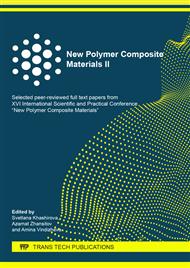[1]
A.E. Dudnik, A.S. Chepurnenko, S.V. Litvinov, Determining the rheological parameters of polyvinyl chloride, with change in temperature taken into account, International Polymer Science and Technology. 44 (2017) 30-33.
DOI: 10.1177/0307174x1704400109
Google Scholar
[2]
S.V. Litvinov, L.I. Trush, S.B. Yazyev, Flat Axisymmetrical Problem of Thermal Creepage for Thick-Walled Cylinder Made of Recyclable PVC, Procedia Engineering. 150 (2016) 1686-1693.
DOI: 10.1016/j.proeng.2016.07.156
Google Scholar
[3]
V.I. Andreev, A.S. Chepurnenko, B.M. Jazyjev, Model of Equal-Stressed Cylinder Based on the Mohr Failure Criterion, Advanced Materials Research. 887-888 (2014) 869-872.
DOI: 10.4028/www.scientific.net/amr.887-888.869
Google Scholar
[4]
A.S. Chepurnenko, B.M. Yazyev, A.A. Savchenko, Calculation for the Circular Plate on Creep Considering Geometric Nonlinearity, Procedia Engineering. 150 (2016) 1680-1685.
DOI: 10.1016/j.proeng.2016.07.150
Google Scholar
[5]
A.S. Chepurnenko, S.B. Yazyev, A.I. Evtushenko, Non-Stationary temperature field modeling in electric cable with PVC insulation, Proceedings. (2017) 8076450.
DOI: 10.1109/icieam.2017.8076450
Google Scholar
[6]
S.V. Litvinov, L.I. Trush, A.A. Avakov, Some features of temperature field definition in axisymmetric problems, International Conference on Industrial Engineering, Applications and Manufacturing. (2017) 1-5.
DOI: 10.1109/icieam.2017.8076449
Google Scholar
[7]
A. Chepurnenko, et al., Calculation of the rotation shells on axisymmetric load taking the creep into account, MATEC Web of Conferences. 106 (2017) 04011.
DOI: 10.1051/matecconf/201710604011
Google Scholar
[8]
L. Trush, S. Litvinov, N. Zakieva, S. Bayramukov, Optimization of the Solution of a Plane Stress Problem of a Polymeric Cylindrical Object in Thermoviscoelastic Statement, Advances in Intelligent Systems and Computing. 692 (2018) 885-893.
DOI: 10.1007/978-3-319-70987-1_95
Google Scholar
[9]
S.V. Litvinov, L.I. Trush, S.B. Yazyev, Determination of the Stress-Strain State of a Rotating Polymer Body, Materials Science Forum. 935 (2018) 121-126.
DOI: 10.4028/www.scientific.net/msf.935.121
Google Scholar


